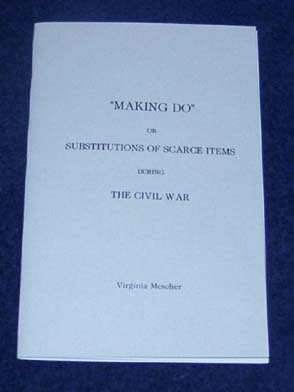Ragged Soldier Sutlery and Vintage Volumes |
|
Generally in Alphabetical Order but with Some Obvious Placement of a Couple of Categories at the Top Home Toys Games Dolls & Accessories Articles: Virginia's Veranda About Us & Picture Books, Modern Books, 19th Century Reproductions Craft Supplies & Sundries Documentation Dolls & Accessories DVD about Emma Edmonds Games Needlework Necessities and Novelties Parlor Games & Entertainments School Supplies Sundries and Craft Supplies Toys Wholesale Information Order Form Ordering Information Contact Us Speaking and Consulting |
Making Do
When the North declared a blockade of Southern ports, frugality switched from being an ordinary virtue to a patriotic duty. Many of the attitudes are captured in the song "The Homespun Dress" which describes how, for the sake of their cause, women could do without many of the niceties they had previously enjoyed and would, by using their ingenuity, develop ways to substitute for commercially made items they could no longer obtain. And if the song is to believed, publicly displaying a homemade item became a source of pride rather than shame about not being able to afford something commercially produced. As the war progressed and the blockade became tighter, more and more items became unavailable. Hence, in 1863, The Confederate Receipt Book was published which provided numerous hints for making goods at home to replace no longer available store-bought goods. Even more telling was the printing of Resources from Southern Fields and Forests which focused on using local materials to replace scarce medicines, especially quinine for malaria. This booklet contains a sample of some of the ways the people of the South coped with shortages. It includes ways to produce clothing items, food makeshifts (including some of the "exotic" meats), replacements for household supplies, and miscellaneous ways to replace ordinarily common items, e.g., glue, or stretch the available supply of scarce items like paper. If the subject is intriguing, the bibliography contains several
sources for additional reading. Price: $3.50 This book is available wholesale for resale.
If you want to look at the previous book in the list,.
|
 The philosophy of "making do," i.e., making a product at
home to serve the function of one purchased already commercially
produced was part what seems to have been an established tradition of
frugality in American culture during the
19th century. A glance at the ladies' magazines, including Godey's
and Petersons's would reveal various receipts (recipes)
for making products at home to avoid purchasing a similar product in a
store.
The philosophy of "making do," i.e., making a product at
home to serve the function of one purchased already commercially
produced was part what seems to have been an established tradition of
frugality in American culture during the
19th century. A glance at the ladies' magazines, including Godey's
and Petersons's would reveal various receipts (recipes)
for making products at home to avoid purchasing a similar product in a
store.